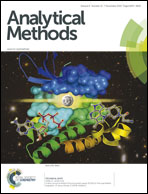Electrochemical sensor for endocrine disruptor bisphenol A based on a glassy carbon electrode modified with silica and nanocomposite prepared from reduced graphene oxide and gold nanoparticles†
Abstract
Based on silica and nanocomposite prepared from reduced graphene oxide and gold nanoparticles (SiO2/rGO–AuNPs), a novel and sensitive electrochemical sensor for bisphenol A (BPA) was fabricated. The electrochemical behavior of BPA on a SiO2/rGO–AuNP nanocomposite was investigated by cyclic voltammetry. Compared with bare GCE, the SiO2/rGO–AuNPs/GCE electrochemical sensor obviously reduced the oxidation overpotential of BPA and greatly enhanced the peak current. The direct detection of BPA was accomplished by using differential pulse voltammetry (DPV) under optimized conditions. A linear voltammetric response to BPA within the concentration range of 3.0 × 10−8 to 1.0 × 10−5 mol L−1 and 1.0 × 10−5 to 1.2 × 10−4 mol L−1 with a low detection limit of 5.0 × 10−9 mol L−1 (S/N = 3) was obtained. In addition, the fabricated sensor was successfully applied to detect BPA in thermal paper samples, and the results were satisfactory.


 Please wait while we load your content...
Please wait while we load your content...